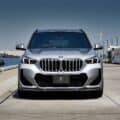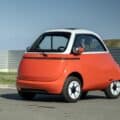Tesla are now expanding a bit further than automobiles, with Tesla Energy. Determined to help end our energy problems in America, Musk has set out to create a more efficient means of storing solar energy. What Tesla Energy has done, is create an in-home battery pack, called the Tesla Powerwall, which can store energy in a far more efficient and economic manner than the conventional battery, which Musk doesn’t seem to care for much. “The issue with existing batteries is that they suck,” says Musk.
The Tesla Powerwall charges itself using solar power but can also draw power from the grid as well. During grid charging, the Powerwall uses a sort of “Smart Charging” to only draw grid power during inexpensive hours and can store the energy for later, such as nighttime. The Powerwall is compact, relatively inexpensive and reliable. It can fit to the wall of a garage and takes up minimal space. Two different Powerwalls are available, 7 kWh for $3,000 and 10 kWh for $,3500, and come in different colors.
The idea of the Powerwall is to make clean, efficient energy a commonplace in America, as well as around the world. These Powerwalls will be available for both home and business use. They will also be able to be linked together, up to ten, to store even more energy.
Another focus of Musk’s for these Powerwalls is emerging markets and remote locations, both of which have poor energy systems and frequent brownouts. Places like this can embrace Powerwalls as cheaper and more efficient means of energy and, according to Musk, “leapfrog” the need for the current style of energy systems. It’s a noble and interesting prospect Musk has, and if anyone can pull off such a feat, it’s him. But what does it mean for the automobile?
Tesla’s automobiles will be able to charge off of these Powerwalls as well. And given that the Powerwall can create very cheap renewable energy, that drops the cost of running a Model S, or any other electric car, dramatically. You can drive the car all day, use the full capacity of the battery, go home and plug it into the Powerwall which will then recharge the car using energy stored by the sun. That seems like a dream for most EV owners, regardless of brand.
The truly great thing about these Powerwalls is that they are created using open-source patents. This means that other companies will be able to create their own versions, using similar technologies, without having to pay Tesla. In doing so, Tesla allows for other companies to want to make these, therefore benefiting the greater good. The ultimate end goal for Musk seems to be getting the world’s cars to run solely on clean, efficient energy and he knows he needs the help of other companies, as he said “It is not impossible, it is something that we can do. But there’s going to [need to] be other companies involved.”
With the technology of the Powerwall being open-source, it isn’t hard to imagine other car companies, like BMW or General Motors, creating their own versions for their electric cars. In doing so, the majority of EV owners would be able to power their EVs far more efficiently and cost effectively, thus lowering the cost of ownership and helping out America’s energy problems. It’s especially easy to see, considering that the cost of these Powerwalls is relatively inexpensive, and even more so when you consider the cost of fueling a car over the course of a few years.
Running EVs with a Powerwall, or similar technology, would give you many cost-free miles and that kind of energy savings multiplied by the millions of people who own EVs could be monumental in helping our dire energy crisis. The Powerwall may seem like a simple idea, but it’s one that could very well help the world. Even if it’s by doing something as simple as running an electric vehicle on solar power.




































































